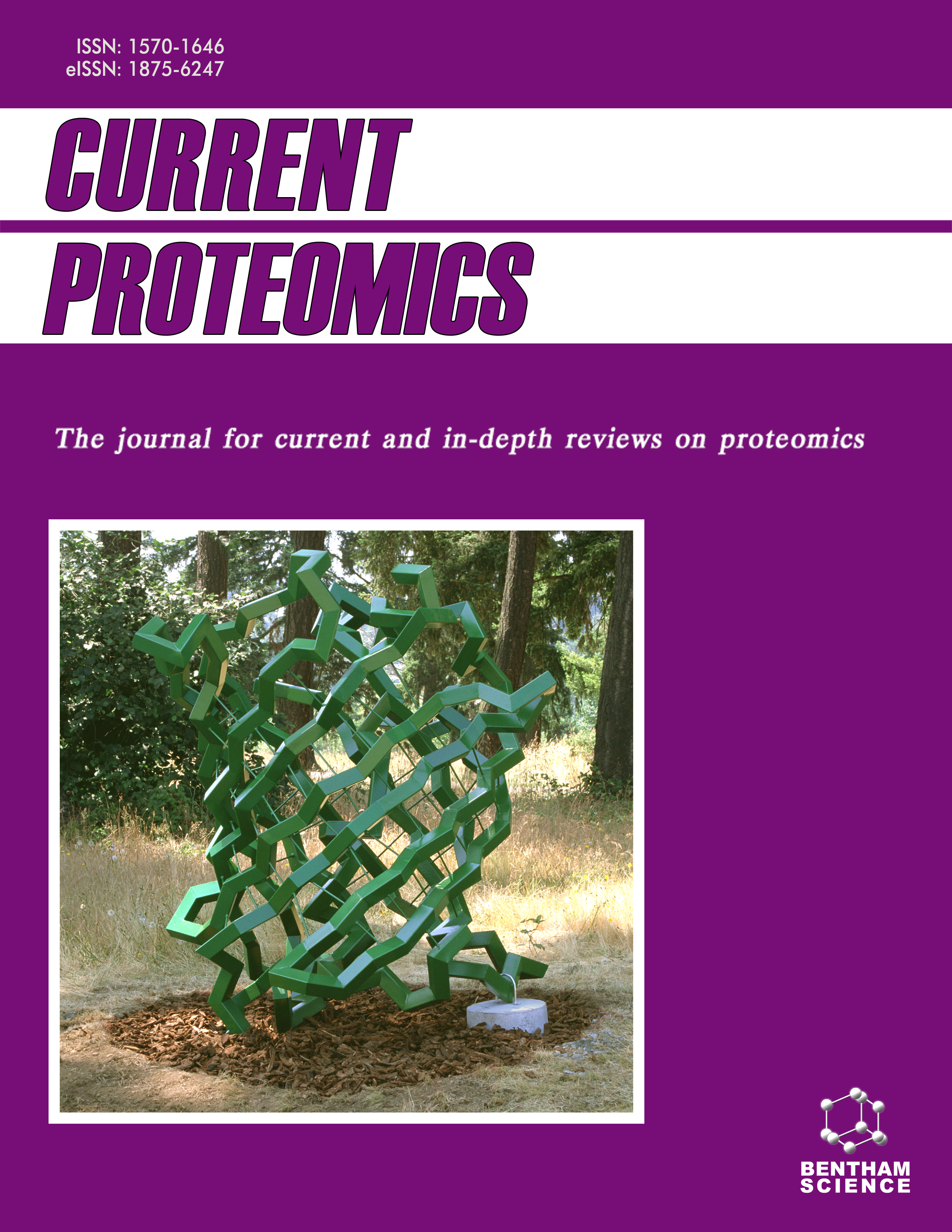Current Proteomics - Volume 3, Issue 1, 2006
Volume 3, Issue 1, 2006
-
-
Three Dimensional Structures of Proteins and Protein Complexes from Chemical Cross-Linking and Mass Spectrometry: A Biochemical and Computational Overview
More LessAuthors: Bulbul Chakravarti, Steven J. Lewis, Deb N. Chakravarti and Alpan RavalIn recent years, protein cross-linking technology using appropriate chemical cross-linking reagents and identification of cross-linked peptides and proteins by mass spectrometry has been used successfully to elucidate the intra- and inter-molecular interactions of protein molecules. Identification of the cross-linking sites within a single polypeptide chain or across polypeptide chains of a protein can provide insight into spatial distance constraints within the molecular structure and hence aid in the prediction of the low resolution three dimensional structure of the protein. In addition, finding cross-linked peptides in a multimeric protein complex is useful for deducing the composition, kinetics, nature of interaction and contact sites of the participating protein molecules in the complex. Here, we describe: (i) commonly used chemical reagents for cross-linking specific amino acid residues in protein molecules, (ii) application of mass spectrometry following digestion of cross-linked proteins with appropriate enzymes of known specificity, (iii) computer software tools for mass spectral data analysis to locate possible sites of intra- and/or inter-molecular cross-linking of protein molecules, and (iv) computational methods for predicting low resolution structure with the help of experimentally identified cross-links. We also discuss various specific examples of the application of the cross-linking technology to the identification of intramolecular and inter-molecular interactions of protein molecules.
-
-
-
The Application of Proteomics for the Early Detection of Lung Cancer
More LessBy Mee S. RohLung cancer is a challenging clinical problem worldwide and it is the leading cause of death from cancer for both men and women. Because of this, the ability to diagnose lung cancer in its early stages is considered crucial to achieve decreased lung cancer mortality. Proteomics has recently been introduced to the field of cancer research, and its potential applications are just beginning to be understood. Unlike the study of a single protein, proteomic technology offers a systemic overview that provides the potential to improve our understanding of lung cancer. Two proteomic approaches are currently being used for lung tissue; matrix assisted laser desorption/ionization-time of flight mass spectrometry (MALDI-TOF) and surface-enhanced laser desorption/ionization (SELDI). Several groups have reported that detection of unique protein peaks can be used to accurately identify pre-malignant lesions, tumor classes and the behavioral aspects of tumors such as the proclivity to metastasize; such proteins involved include translation elongation factor-1 delta, 14-3-3, small ubiquitin-related modifier-2 and thymosin-4. Proteomics may have the potential to detect early changes in dysplastic lesions that predispose them to malignant transformation. In this review, these perspectives on the molecular targets for early detection of lung cancer will be discussed and summarized.
-
-
-
Chemistry in Proteomics: An Interplay between Classical Methods in Chemical Modification of Proteins and Mass Spectrometry at the Cutting Edge
More LessThis review deals with chemical approaches that facilitate proteomics research. The methods include chemical cleavage of peptide bonds, stepwise degradation of proteins, and site-specific modification enabling the discrimination between functional groups. These reactions could enhance the efficacy of mass spectrometry (MS) for identification, quantification, and sequencing of peptides and proteins. Particular stress is laid on the effect of each modification on mass spectra mainly with respect to the enhancement of peak intensities, the clarity of spectra, and the suppression of ambiguity in peak assignment. Chemical modifications targeting the terminal free amino and carboxyl groups are reviewed, because the charge or isotopic tagging on N- and C- termini has proved effective to identify a protein based on the terminal amino acid sequencing with tandem MS in combination with database searching. Such a tag that is designed to provide a peak with a characteristic sensitivity or pattern could corroborate the implication of mass spectra and facilitate the de novo protein sequencing of mature proteins, which are often subjected to post-translational modifications.
-
-
-
Separation Media in Affinity Chromatography of Proteins - A Critical Review
More LessAuthors: Tereza Varilova, Milan Madera, Vera Pacakova and Karel StulikThe rapid development of proteomics has been made possible primarily by the progress in analytical and preparative separation methods. Biological systems are so complex that the separation procedures employed must be highly efficient as well as highly selective. The latter requirement is best met by affinity separations based on molecular recognition. The present review critically discusses the properties of the affinity sorbents employed in proteomics, namely, agarose gels, dextrans, modified methacrylate and acrylamide polymers, porous and nonporous silica, porous glass beads, monoliths, affinity membranes and magnetic beads. The physico-chemical properties of these materials, their preparation, application, approaches to their modification and their relative advantages and drawbacks are discussed.
-
Volumes & issues
-
Volume 21 (2024)
-
Volume 20 (2023)
-
Volume 19 (2022)
-
Volume 18 (2021)
-
Volume 17 (2020)
-
Volume 16 (2019)
-
Volume 15 (2018)
-
Volume 14 (2017)
-
Volume 13 (2016)
-
Volume 12 (2015)
-
Volume 11 (2014)
-
Volume 10 (2013)
-
Volume 9 (2012)
-
Volume 8 (2011)
-
Volume 7 (2010)
-
Volume 6 (2009)
-
Volume 5 (2008)
-
Volume 4 (2007)
-
Volume 3 (2006)
-
Volume 2 (2005)
-
Volume 1 (2004)
Most Read This Month


